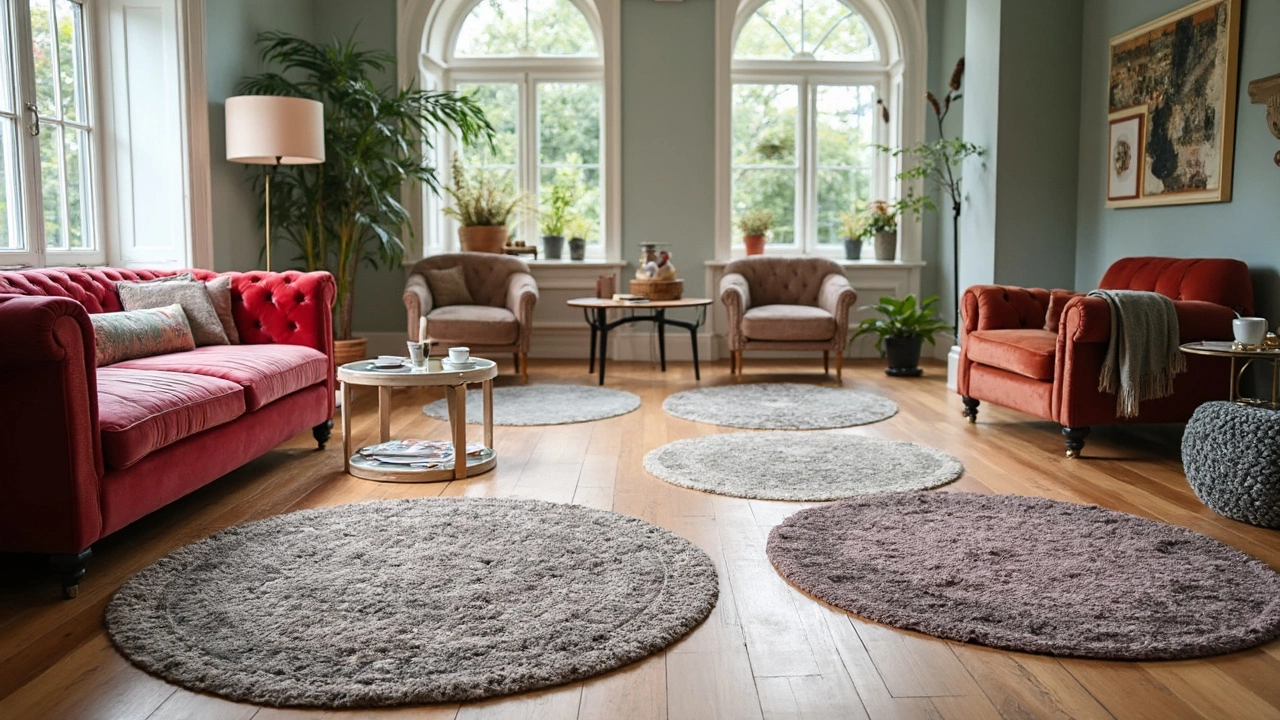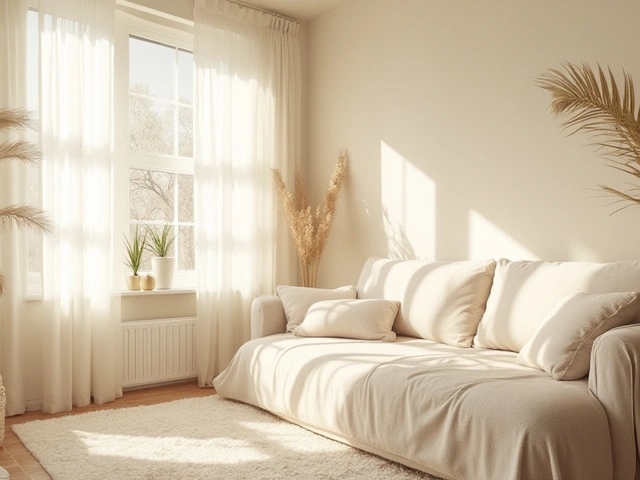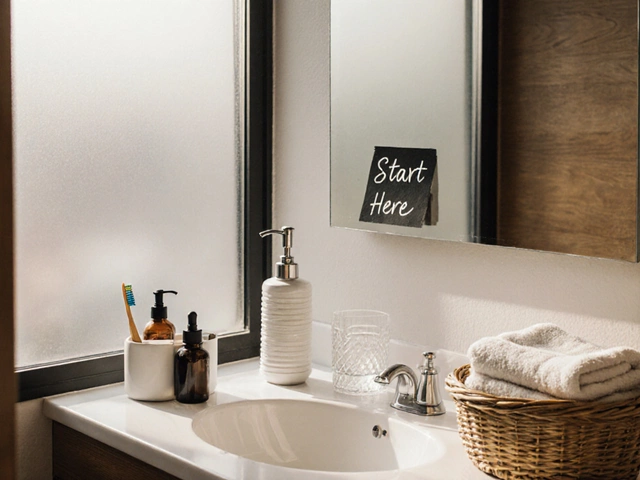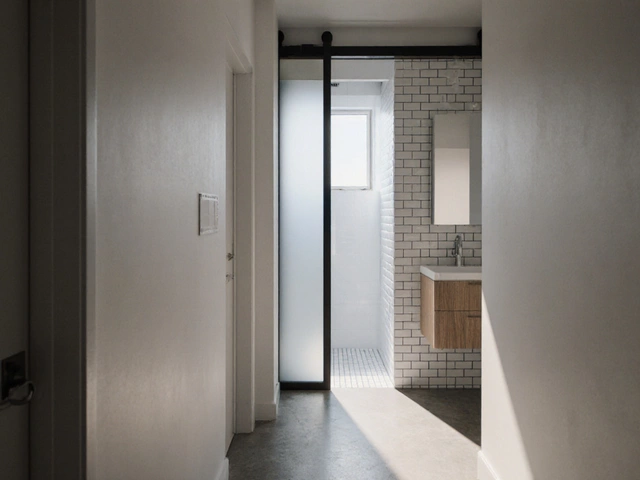What Shape Rug Is Best? How to Pick the Perfect Fit

If you've ever stood in a store, staring at a pile of rugs and wondering, "But what shape do I actually need?"—you're not alone. The shape of your rug isn't just a little detail. It can totally change how your room feels, even more than color or texture sometimes. Get it right, and your space looks bigger, cozier, and way more pulled together. Pick the wrong shape, and something just feels off: furniture floats, walkways get blocked, and that expensive rug might barely get noticed (or trip people!).
Here's the real deal: there's no single "best" rug shape, but there's always one that works better for your room, your furniture, and your style. Some shapes help open up tight spaces. Others can highlight your favorite pieces or even make a statement all by themselves. And sometimes, you'll need a few different shapes to make it all click. Knowing the basics saves you money, headaches, and a lot of returns.
- Why Rug Shape Matters
- The Classics: Rectangle and Square Rugs
- Round Rugs: When to Go Circular
- Runner Rugs and Odd Shapes
- Matching Rugs to Room Shape and Furniture
- Tips and Common Mistakes to Avoid
Why Rug Shape Matters
Ever wonder why one room just clicks and another feels off, even if all the furniture is in the right place? It often comes down to the shape of the rug. The rug shapes you choose can influence the entire mood and function of a room. The human brain notices patterns and outlines before we even register color or fabric. A round rug can soften sharp corners, while a rectangular rug can add structure in big, open spaces.
Getting the right rug shape isn't just about trends, either. Designers say that matching the rug to the outline of your space helps the room look balanced. For example, a long oval or runner works in a hallway, but not in a square dining room. The wrong-shaped rug can make your furniture look lost or make walkways confusing.
Room size matters, too. If you only remember one thing, remember this: A too-small rug, no matter the shape, makes your room shrink visually. But if you pick a rug shape that follows your furniture layout (like a big rectangle under a sofa setup, or a round rug under a round table), everything feels more relaxed and intentional.
- Rectangle and square rugs work best for formal areas or when you want to line up with walls.
- Round rugs are perfect for playful zones, kids’ rooms, or under round tables.
- Runner rugs guide the eye down a hallway or entrance and help prevent slips.
- Odd shapes (like animal hides or asymmetrical cuts) add some fun but need careful placement.
A 2023 survey by the National Wood Flooring Association says 80% of pro designers choose rug shape first, before even color, because it sets the skeleton of the room. If you want your space to look finished—start with shape. That’s why it’s a huge deal in home decor and interior design.
The Classics: Rectangle and Square Rugs
When people talk about rug shapes, almost everyone pictures rectangles or squares first—and for good reason. These shapes are the most common because they fit with how rooms are usually built. Most living rooms, bedrooms, and dining rooms are shaped like a rectangle or square themselves, so dropping in a rug with matching corners makes sense. It just feels right underfoot and looks tidy.
Rectangular rugs are the big workhorses in home design. They're go-tos for defining spaces—think the cozy zone under your sofa or the main walking path in an open-plan room. They also make rooms feel longer or wider, depending on how you lay them out. For example, turn a rectangular rug the same direction as the longest wall, and suddenly your room looks bigger. In fact, a 2023 home survey from a major interiors site showed that nearly 78% of buyers still pick rectangles as their first choice for living rooms.
Square rugs aren’t as common, but they work wonders in boxy bedrooms, small dining areas, or any place where the furniture layout is neat and symmetrical. They’re especially great for square-shaped coffee tables or under four-seat dining sets—everything feels balanced and lined up.
Here are a few practical tips for using these classic rug shapes:
- Living room: Pick a rug big enough for at least the front legs of couches and chairs to sit on the rug—a common mistake is going too small.
- Dining room: The rug should be large enough so that even when chairs are pulled back, they’re still on the rug. A quick trick—add 24 inches to each side of your table’s measurements.
- Bedroom: Try to let the rug extend a couple feet past the bottom and sides of your bed—this keeps bare feet comfy in the morning and anchors the whole setup.
Here’s a basic sizing table if you’re not sure where to start:
| Room | Common Rug Size |
|---|---|
| Living Room | 8'x10', 9'x12' |
| Dining Room | 8'x10' (fits 6-8 chairs) |
| Bedroom | 8'x10' for queen, 9'x12' for king |
The bottom line? If you’re in doubt, rectangles and squares almost always work. They’re the safe bets if you want your space to feel put-together and classic—no second-guessing.
Round Rugs: When to Go Circular
You’ve probably noticed that round rugs pop up in magazines and Instagram home tours, especially lately. And there’s a reason designers keep reaching for a circle over the usual rectangle. Round rugs can break up the boxy look of most rooms, making everything feel softer, a little more playful—even more open. They’re perfect when you want something different from the usual straight edges.
So, when does a round rug actually make sense? Here are some go-to scenarios:
- Small spaces: A round rug in a tight entry, petite nursery, or even a reading nook tricks the eye into thinking the space is bigger and less cramped.
- Furniture with curves: If you’ve got a round dining table or a curved coffee table, a round rug just makes sense. It echoes those shapes, making everything look like it belongs together.
- Creating a spotlight: Have one standout item, like a statement chair or plant? Plop it on a round rug. It’s like giving your favorite thing its own little stage.
- Open-concept layouts: In big, open rooms, circles help define areas without hard lines, carving out dining corners or conversation spots without walls.
One mistake people make: grabbing a round rug that’s too small. If you’re going under a round dining table, the rug needs to be large enough that even when folks pull their chairs out, the chair legs are still on the rug. The general rule is at least 24-30 inches larger than your table diameter. Got a 48-inch table? You want at least a 72-inch rug—or even 78 inches for more comfort.
| Room Type | Ideal Round Rug Size |
|---|---|
| Small Entryway | 3 – 4 feet |
| Dining with Round Table | 6 – 8 feet |
| Living Room Accent | 5 – 7 feet |
| Kids’ Room | 4 – 6 feet |
If you’re mixing rug shapes in one room, add a round in with some rectangles for visual interest. Just don’t press a round rug up against a wall or stick it in a hallway—circles need a little breathing room, or they look awkward fast.
Round rugs work especially well with boho, mid-century, or eclectic homes, but if your space is modern or farmhouse, you can pull them off too. It’s really just about what feels good when you walk in. Circles can soften hard angles, highlight favorite spots, and shake up boring layouts. Start with the size. Then have some fun with color or texture.

Runner Rugs and Odd Shapes
Don’t let narrow spaces or awkward nooks stress you out. That’s where runner rugs and all those odd-shaped options step in. You see runners most often in hallways and entryways, but they do way more than just fill a skinny floor. They keep high-traffic zones from getting worn out, help muffle sound, and actually make long, plain areas look interesting. If you want a quick upgrade for a boring hallway, slap down a colorful runner and watch how different it feels.
The standard width for a runner is around 2 to 3 feet, but the length ranges tons—usually 6 to 14 feet. That means you can easily size one to fit almost any passage. Just make sure you leave 4 to 6 inches of bare floor on each side, so it doesn’t feel cramped. In kitchens, running a long rug behind an island or in front of a counter is way more comfortable for your feet than plain tiles. Same goes for beside the bed if you don’t want cold feet first thing in the morning.
Now, about those funky shapes—think animal hides, hexagons, or even free-form pebbly ones you might see in modern homes. These can make a home decor statement, but they do take a little guts to pull off. Use them when you want to break up the boxy look of a room or call attention to one part, like under a funky coffee table or in a reading corner. Odd shapes can be tricky around big furniture, so start with smaller spots where they won’t get hidden.
- Runner rugs are perfect for galley kitchens and narrow bathrooms—not just hallways.
- Odd-shaped rugs work best in open spaces where their whole design shows.
- If you have pets, avoid shaggy odd shapes (they’re dust magnets and hard to vacuum).
- Custom runners are getting easier to order—lots of online shops cut to size these days, so you’re not stuck with whatever’s in-stock.
Here’s a quick snapshot of where people usually use runners:
| Room/Space | Recommended Runner Size | Common Reason |
|---|---|---|
| Hallway | 2.5'x8' | Protects high-traffic zones |
| Kitchen | 2'x6' | Cushion for feet, decor |
| Entryway | 2'x10' | Welcomes guests, traps dirt |
To sum it up: runner rugs keep things practical and stylish, while odd shapes are for folks who want a little personality in their space. Just remember to measure twice and check how much floor you want to show—nobody loves a rug that looks too stuffed in or totally lost.
Matching Rugs to Room Shape and Furniture
This is where rug shopping goes from “guess and hope” to flat-out smart design. The shape of your rug should almost always echo the shape of your room or the furniture group you’re working with. Why? When the rug lines up with what’s already there, it pulls everything together and grounds your space. No more floating couches or awkward angles.
The classic rule: If your room is rectangular (like most living rooms and bedrooms), a rectangular rug is usually your best bet. It stretches out under your main pieces, helps frame the zone, and makes everything look organized. Same deal goes for square rooms; square rugs work best there.
- In the dining area, the shape of your table is key. Got a round table? A round rug makes everything feel balanced, and nobody gets stuck with the weird angled corner. If you have a rectangular or oval table, stick to a rectangular rug—make sure it’s big enough so the chairs stay on the rug even when they’re pulled out.
- For the bedroom, rectangle rugs work under most beds. The standard move: run the rug perpendicular to the bed, so it extends past both sides and the end. If you want something different, try two runners beside the bed for a modern, hotel vibe.
- If you’ve got a square seating group—like four armchairs facing each other—use a square rug. It’ll frame this layout perfectly and keep everything looking intentional.
Here’s a power tip: In open-concept spaces, rugs are incredible at defining zones. For example, a large rectangular rug shows where the living area ends and the dining room starts, even if there’s no wall. If you’re working with odd-shaped spaces, a round rug can soften hard lines and make everything feel more relaxed and welcoming.
Still unsure which size or shape will hit the mark? A simple trick—map out your rug size and shape with painter’s tape on the floor. Move your furniture around and see what fits the flow. Here’s a look at common rug shapes and the most popular spots they get used:
| Rug Shape | Best Room/Furniture Match |
|---|---|
| Rectangle | Living rooms, bedrooms, dining tables (rectangle/oval) |
| Round | Breakfast nooks, round tables, foyers |
| Square | Small rooms, square seating layouts |
| Runner | Hallways, kitchens, alongside beds |
So before you swipe your card, think about the room and furniture first. You want your rug to work with what you’ve got, not fight against it.
Tips and Common Mistakes to Avoid
You can pick the most expensive rug in the shop, but if you miss on shape or placement, it’ll just end up looking awkward. These tips can help make sure your rug actually brings the room together, not apart.
- Measure, Measure, Measure: Don’t just eyeball it. Grab a tape measure and jot down your sofa, dining table, or bed dimensions before buying. Most people end up with rugs that are way too small. The pros say your rug should anchor the furniture – living room rugs should reach under the front legs of couches or chairs.
- Watch Your Walkways: If people have to walk half on and half off the rug, it’s a tripping hazard. For strong rug placement, leave at least 18-24 inches of bare floor (or more, in big spaces) around your rug’s edge so the room feels spacious, not crowded.
- Match Rug Shape with Room Shape: Got a round dining table? Go with a round rug. Rectangle dining tables or living rooms usually look better with a rectangular shape, since it guides the eye and lines up with the furniture. This is where home decor choices really shine—matching shapes just makes sense.
- Don’t Ignore Layering: Sometimes, layering a smaller round rug over a big rectangular one adds depth (and gives those odd-shaped favorites a home).
- Skip High-Pile Rugs Under Dining Tables: High-pile may look nice, but cleaning crumbs out is a nightmare. Go for low-pile or flatweave in eating spaces to save yourself trouble.
- Runner Rugs Go Where Traffic Is: Hallways, kitchens, and even next to your bed are prime spots for runner rugs. They help cushion feet and also guide people through your space.
Here are some stats that might help you decide:
| Room Type | Most Popular Rug Shape | Average Rug Size |
|---|---|---|
| Living Room | Rectangle | 8'x10' or 9'x12' |
| Dining Room | Rectangle or Round | 8'x10' (rect), 8' (round) |
| Bedroom | Rectangle | 6'x9' or runners |
| Hallway | Runner | 2'6''x8' |
Here’s the bottom line: when in doubt, bigger is almost always better with rug shapes and sizes. Undersized rugs make rooms look smaller and disconnected. And never rush to buy without thinking about foot traffic and cleaning—style is fun, but you want your home decor to feel good for real life too.





